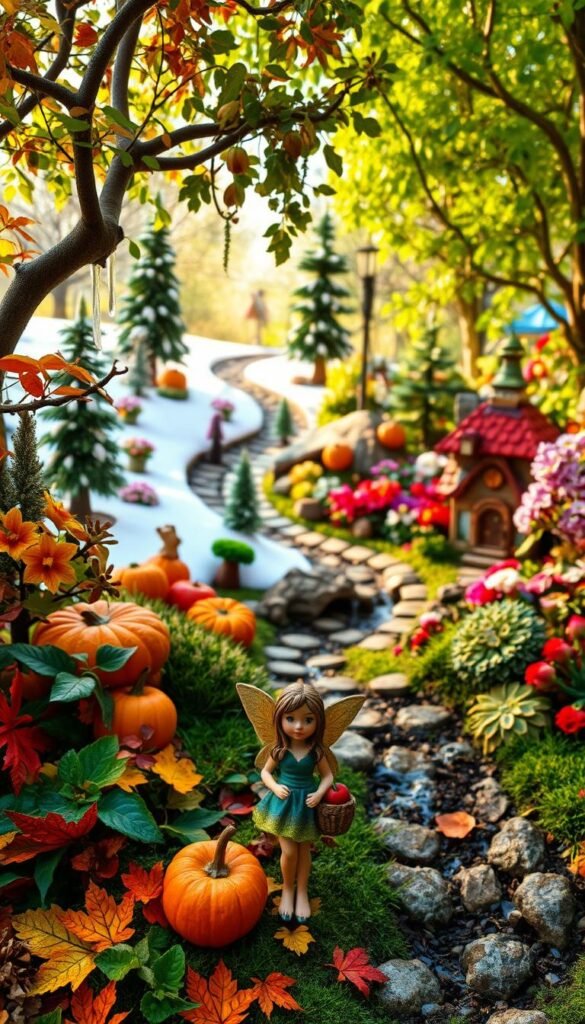Welcome to the magical realm of miniature landscapes that capture imagination. These tiny, enchanting spaces first charmed audiences at the 1893 Chicago World’s Fair. Today, they bring whimsy to homes and patios across the country.
Your tiny wonderland can mirror nature’s rhythm with thoughtful adjustments. Imagine swapping autumn leaves for snow-dusted accents or spring blossoms for summer greenery. These changes keep your display fresh and engaging through rotating themes.
This guide reveals simple ways to refresh your setup. You’ll learn to use natural materials like pinecones or dried flowers. Even small tweaks create big transformations, letting your creation evolve with Earth’s cycles.
Whether you’re new to crafting mini scenes or a seasoned creator, these ideas spark creativity. Discover how tiny houses, bridges, and figures gain new life when paired with seasonal textures. Your evolving displays will delight visitors every month.
Welcome to Your Magical Fairy Garden Adventure

Unlock the door to whimsical creations that delight all ages. These miniature escapes work for everyone – whether you’ve got green thumbs or just love tiny details. You don’t need fancy tools or rare plants to start crafting your first scene.
Begin with simple projects like arranging pebbles around a teacup cottage. Use broken pottery shards as pathways or bottle caps as ponds. Your imagination turns everyday items into storybook elements that spark conversations.
| Skill Level | Materials | Time Needed |
|---|---|---|
| Beginner | Thrift store finds | 15 minutes |
| Intermediate | Craft store supplies | 1 hour |
| Advanced | Custom-built pieces | 3+ hours |
These projects become stress-relieving hobbies that grow with you. Start with a single succulent in a mug, then expand to multi-level landscapes. Each creation reflects your personality through color choices and tiny accessories.
Children love adding miniature animals, while adults enjoy designing zen rock gardens. Your evolving displays become living art that changes with your mood – no two scenes ever look alike!
Understanding the Enchantment of Fairy Gardens

Step into a world where tiny wonders spark big smiles. These miniature escapes blend art and nature in palm-sized spaces. Let’s explore why these creations captivate hearts across generations.
What Makes a Fairy Garden Special?
Your mini masterpiece becomes a portal to imagination. Tiny cottages built from bark and pebbles invite storytelling. A moss carpet or acorn cap bowl adds authentic texture you can touch.
These gardens thrive on hidden surprises. A miniature door under a mushroom? A stone bridge crossing twig rails? Each detail rewards closer inspection. You control the narrative through clever arrangements.
| Historical Element | Modern Twist | Key Material |
|---|---|---|
| Victorian terrariums | LED-lit scenes | Glass containers |
| Folk tale figures | 3D-printed gnomes | Biodegradable plastic |
| Herb gardens | Succulent landscapes | Drought-resistant plants |
The History and Charm Behind Miniature Worlds
People have crafted small-scale scenes since ancient Rome. But the modern version took root in 1890s England. Gardeners filled glass cases with ferns and tiny furniture – early indoor gardens.
Today’s versions keep that sense of discovery. You might recreate a woodland stream with mirror shards. Or build a beach scene using aquarium sand. The joy comes from shrinking nature’s grandeur into something you can tend daily.
Starting Your Fairy Garden Journey with a Teacup Garden
Transform ordinary teacups into tiny wonderlands that spark joy in cramped corners. These palm-sized projects let you test design ideas without commitment. A thrifted cup becomes a cozy cottage when paired with moss and miniature decor.
Choosing the Perfect Teacup and Accessories
Look for cups with character – chipped edges add rustic charm, while floral patterns inspire cottagecore themes. Thrift stores offer budget-friendly options, but even mismatched saucers work as bases. Pair your find with these essentials:
| Teacup Type | Best For | Recommended Accessories |
|---|---|---|
| Oversized Mugs | Multi-level scenes | Mini ladders, tiny ferns |
| Delicate China | Vintage displays | Pearl beads, lace trim |
| Earthenware | Rustic designs | Twig fences, pebble paths |
Simple Setup Ideas for Any Space
Create instant magic in four steps. First, add gravel for drainage. Next, layer potting soil. Then, position small succulents or faux plants. Finally, place your favorite tiny figures – gnomes, rabbits, or sparkling fairies.
Desktop displays thrive with air plants needing minimal care. For sunny windowsills, try drought-resistant sedums. Rotate seasonal accents like miniature pumpkins or glittery snowflakes to keep your scene fresh year-round.
Seasonal Fairy Garden Updates: Decorating for Fall, Winter, Spring, and Summer

Breathe new life into your miniature wonderland as Earth cycles through its annual transformations. Tiny landscapes thrive when refreshed with nature-inspired accents that mirror outdoor changes.
Autumn calls for rustic charm. Swap summer greenery for cinnamon sticks and maple leaf replicas. Mini hay bales and acorn caps create harvest vibes. Add a scarecrow figurine beside your tiny cottage for whimsy.
When frost arrives, sprinkle crushed quartz for snowdrifts. Nestle pinecone trees beside a mirrored ice-skating pond. Red berry clusters and miniature string lights bring holiday warmth to chilly scenes.
- Revive spring displays with budding twigs and eggshell planters
- Use beach glass and seashells for summer coastal themes
- Rotate flowering plants like pansies or marigolds seasonally
Overgrown blooms? Transplant them to your yard! This natural rotation keeps your setup fresh while expanding your outdoor landscape. Store seasonal accessories in labeled jars for quick swaps.
“A well-timed update makes your creation feel alive – like it weathers storms and celebrates sunshine alongside you.”
Experiment with textures: burlap for fall, glitter for winter frost, silk petals for spring blossoms. These tactile changes delight both eyes and fingertips during each transition.
Transforming Broken Pots into Enchanted Mini Landscapes

Cracked clay pots hold secret potential. Instead of tossing damaged planters, you can craft layered worlds where tiny stories unfold. These accidental fractures become design features when approached creatively.
Breathing New Life Through Creative Repurposing
Start by arranging pot shards into terraced levels. Place the largest piece as your base, then stack smaller fragments like natural stairs. Fill each layer with soil mixed with perlite for drainage. This creates perfect planting pockets for mini succulents or moss.
| Traditional Design | Broken Pot Advantage | Key Feature |
|---|---|---|
| Flat layout | Vertical interest | Elevated planting zones |
| Single material | Texture contrast | Rustic ceramic edges |
| Basic access | Hidden pathways | Tier exploration |
Connect levels with twig ladders or pebble steps. A magical fairy garden base gains depth when fairies appear to tend different “floors.” Add tiny signs pointing to upper-level cottages or root cellar storage.
This cute way to recycle teaches sustainability through play. Kids love hiding surprises in crevices – maybe a gemstone pond or sleeping hedgehog figure. Adults appreciate how imperfections become artistic assets.
Broken edges get mossy charm over time. The layered structure helps plants thrive by preventing waterlogging. Your once-discarded pot becomes a conversation piece that grows more interesting with each season.
Designing Delightful DIY Fairy Garden Scenes for Kids

Spark wonder in young minds with miniature worlds they can shape themselves. These pint-sized projects turn recycled containers into stages for storytelling, blending playtime with gentle nature lessons.
Fun and Simple Crafts for Young Gardeners
Start with clean mason jars or 4-inch clay pots. Let kids layer pebbles, soil, and moss to create their base. Cheerio-sized accessories like bottle-cap ponds or clothespin bridges keep costs low while fueling creativity.
Host a crafting party with pre-packed kits containing:
- Miniature animals or peg dolls
- Assorted natural textures (pinecones, acorns)
- Non-toxic glue sticks and safety scissors
Children love arranging twig fences around pretend campsites or designing pebble pathways to secret caves. “The messier their creation, the better,” says kindergarten teacher Mara Simmons. These projects teach patience as young gardeners wait for chia seeds to sprout “magic forests.”
Use dollar-store finds for quick transformations – plastic gems become crystal caves, while craft foam turns into mushroom houses. Rotate displays on windowsills to track plant growth, turning care routines into science lessons.
Crafting Captivating Fairy Terrariums and Suspended Accents
Discover how glass containers become portals to miniature magic. These self-contained ecosystems let you design lush scenes that thrive with minimal care. Mason jar creations shine as both home decor and thoughtful gifts, glowing softly after dark with embedded LEDs.
Building Miniature Terrariums
Start by layering materials for plant health. Add pebbles at the base for drainage, followed by activated charcoal to keep the air fresh. Top with potting soil mixed with sand for proper root growth.
Choose plants that stay small, like ferns or moss. Arrange tiny furniture among the greenery—think wooden benches or ceramic cottages. Wrap fairy lights around a central tree replica for nighttime sparkle.
These living displays evolve over time. Mist them weekly and rotate for even light exposure. Hung near windows, suspended versions become floating gardens that catch sunlight and curious glances.
- Clear glass for maximum visibility
- Proper ventilation to prevent mold
- Scale-appropriate accessories
- Energy-efficient lighting
Turn basic jars into conversation starters. Swap decorative elements seasonally—pastel flowers for spring, golden leaves for autumn. Each adjustment tells a new chapter in your tiny world’s story.
Incorporating Succulent Elements for a Lush Fairy Village
Turn drought-resistant plants into storybook settings that thrive with minimal effort. Succulents bring sculptural beauty to tiny landscapes, their plump leaves mimicking enchanted forests in miniature form. These hardy varieties let you focus on creativity rather than constant upkeep.
Selecting Low-Maintenance Varieties
Choose Echeveria for rosette shapes that resemble blooming flowers. Sedums work as ground cover, while stacked crassulas mimic tiny trees. Look for slow-growing types like Haworthia to maintain scale. Most need just bright light and monthly watering – perfect for busy creators.
Designing With Shape and Texture
Arrange taller specimens as backdrop “woods” behind cottage replicas. Use rounded varieties as boulders along pebble paths. Tuck moss between plants for velvety contrast. Pro tip: Rotate potted succulents weekly to ensure even growth patterns.
Add whimsy with miniature signs pointing to “mushroom markets” or “fairy libraries.” A gravel walkway winding through your succulent fairy garden invites exploration. These resilient plants adapt to your vision, turning any container into a self-sustaining slice of magic.






